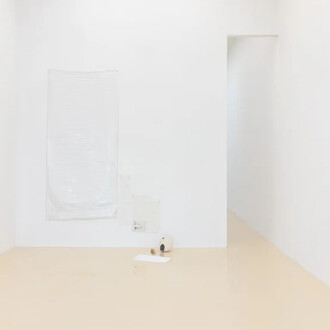Monika Sprüth and Philomene Magers are pleased to announce EMO, a solo exhibition by Anne Imhof, representing the largest presentation of the artist's work in the United States to date and her first in Los Angeles.
Over the past decade, Imhof has developed a deeply moving and varied practice that encompasses painting, drawing, sculpture, installation, video and performance. Following her recent exhibitions at Palais de Tokyo, Paris (2021), Stedelijk Museum, Amsterdam (2022) and Sprüth Magers, London (2022), EMO brings together several bodies of work across multiple mediums, putting each in dialogue with found objects in ways that implicate visitors' bodies as they move through the space, at turns exalting and frustrating the viewing experience.
Visitors enter and first encounter a labyrinth of industrial water tanks that snakes through the gallery's ground floor, creating hallways, enclosures and windows bathed in a deep-red glow. The tanks' caged armatures stretch several feet high, obscuring both the viewer's physical path and their sight lines onto Imhof's paintings, several of which are cloistered within this aluminum-clad maze, at times only partially visible, or seen from an unusually short distance. The artist regularly plays with the anxiety and anticipation around what can and cannot be seen, what remains hidden and in need of excavation, as well as the charged nature of empty spaces. Here, grasping the entire picture becomes impossible; instead, viewers must forge a path and narrative for themselves amid Imhof's architecture of hollow water tanks.
Though Imhof is perhaps best known for her live performances, she conceives her work not only from the vantage point of performance, but also painting. Several of the artist's recurring motifs appear on panels and canvases, including the jester, or clown; billowing Technicolor clouds; collaborators from past performances; and "scratches." For Imhof's aluminum works, she inscribes an intensely repeating linear gesture onto the painted panel, as if to deface, or to mark her body's presence, amid its pristinely applied industrial pigments. The paintings in EMO are on the whole figurative, representing a departure from Imhof's largely abstract painterly practice. They also include techniques recently added to the artist's oeuvre, in which bright reds and turquoise are superimposed over imagery to create a multilayered, three-dimensional effect that complicates the works' two-dimensional nature.
The architectural high drama that Imhof has staged on the ground floor is reprised on the second, where a full-sized billboard, which seemingly crashes through the gallery ceiling, serves as a projection screen in a nod to LA's urban cityscape. Timed at different intervals are two of Imhof's newest films, both shot around Moscow in the early months of 2022 before Russia's invasion of Ukraine. In Youth (2022), a group of horses runs and communes together in an open field covered in freshly fallen snow. They seem to nurture one another, moving beautifully and freely through this natural environment to the baroque strains of J. S. Bach's St. Matthew Passion. As day moves slowly into night, the camera gradually reveals the site to be an urban one, a historic social housing development located at the edge of the city. Yet the utopian feeling created between these animals is unmarred by this revelation.
AI Winter (2022), on the other hand, presents a human figure entrapped. Shirtless and unflinching amid the harsh Russian winter, and using repetitive, machinelike gestures, performer Eliza Douglas walks briskly around and between the architectural ruins housed within Moscow's Gorky Park. Recognizable for its angular geometries of wood and concrete, this structure was built in the early twentieth century to house agricultural expositions, but over the years fell into ruin, becoming a space for raves, a squat and later a place for illicit drug use. As the performer's body navigates this site, both its movements and those of the camera revolve around a middle space that remains empty, yearning for resolution. Both Youth and AI Winter transmute into the language of film the powerful elements of staging, movement and choreography inherent to Imhof's performative work.
These and other works come together in EMO in ways that both coordinate and contradict, from the aluminum armatures of the water tanks and billboard, to the hard and soft of metal and skin, offering a study of contrasts between the natural and unnatural, human and animal, and human and machine. Throughout the exhibition, Imhof—an outsider in LA—also pays homage to the city and its particular homegrown industries, as well as to its legacies of performance and spectacle that align closely with her own practice.
Anne Imhof (1978, Gießen) lives and works in Berlin and New York. Selected solo exhibitions include Stedelijk Museum, Amsterdam (2022), Palais de Tokyo, Paris (2021), Castello di Rivoli, Museo d'Arte Contemporeana, Turin (2021), Tate Modern, London (2019), Art Institute of Chicago (2019), Hamburger Bahnhof, Berlin (2016), Kunsthalle Basel (2016), MoMA PS1, New York (2015), Carré d’Art – Musée d’Art Contemporain de Nîmes (2014), and Portikus, Frankfurt am Main (2013). Her work has also been featured in numerous group exhibitions worldwide, including La Biennale di Venezia 2017, where she was awarded The Golden Lion. Imhof co-writes the music for her performance pieces, including Angst, Faust (both together with Franziska Aigner, Billy Bultheel, Eliza Douglas) and Sex (together with Bultheel, Douglas, and Ville Haimala). In 2017, her debut single, Brand New Gods was released and her debut album, Faust, was released by PAN in 2019.
















